Invasion of round goby (Neogobius melanostomus) from the
Ponto-Caspian to the Baltic
Mariusz R. Sapota
University of Gdansk
Institute of Oceanography
Dept. of Marine Biology and Ecology
Al. M. Pilsudskiego 46, 81-378
Gdynia
Poland
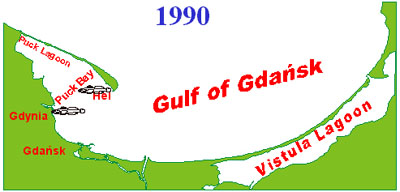 |
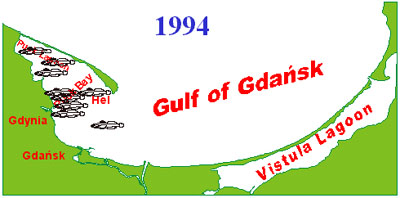 |
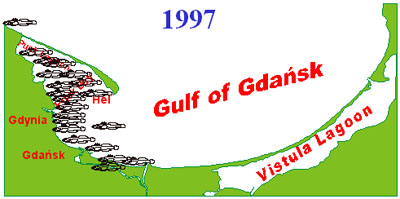 |
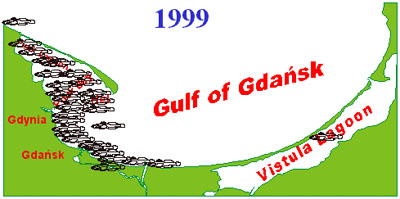 |
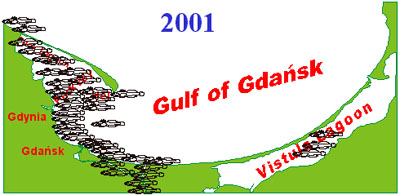 |
The spread in the
distribution of the round goby in the Gulf of Gdansk over the last
decade can be clearly shown
The invasion of round goby (Neogobius melanostomus)
from the Ponto-Caspian region is a relatively new introduced species
into the Baltic Sea, currently over a hundred species are known as man
introduced into the Baltic.
In 1990, the first round gobies were caught in the Gulf of Gdansk and
in the Great Lakes in the North America indicating the start of an
invasion!
In June 1990, despite the origin and the route of transport being
unknown (it is now surmised that the route of transport was in ships
ballast waters), the first round gobies were caught in the vicinity of
port in Hel, on the tip of the Hel Peninsula. In the same year, more
round gobies were caught near Hel and Gdynia harbors. Over the next few
years, the colonisation of new regions and an increase in round goby
numbers occurred and from 1999, the round goby became one of the more
dominant species in the shallow water zone in the west part of the Gulf
of Gdansk.
Currently, three geographically separated groups of round gobies
exist in the Gulf of Gdansk and its vicinity. The largest occupies the
shallow waters of the west part of the Gulf of Gdansk; it is stable and
well established. The second one on the west border of the Gulf of
Gdansk is small and slowly growing. The third one in the Vistula Lagoon
has started to grow rapidly in 2001. The new groups originate from the
population inhabiting the west part of the Gulf of Gdansk and the
discrete distribution suggests that transport in ballast waters was also
the way the new groups were established.
Why invasion is a success
A number of biological features of the round goby support its
invasion success, the most important being its high tolerance of a range
of environmental factors and its effective spawning strategy.
Round gobies typically occur in shallow waters (from less than one to
about 20m depth) and they always occur near bottom. Hard seabed habitats
are preferred, however the invasion of the general sandy bottomed Gulf
of Gdansk started near the harbour regions, where the concrete piers
provided refuge for the fish.
In the Gulf of Gdansk, the round goby can grow up to 25cm in length.
However the majority of individuals are between 8 and 18 cm in length
making them one of the biggest fish in area. Their life span is rather
short, three to four years, with the females living about three years
and the males one year longer and reaching a larger size.
In the Gulf of Gdansk, they generally spawn from the beginning of May
to the end of September. Although this is prolonged during warmer years.
The male to female ratio is approximately three or two to one in
contrary to native populations where the sex ratio is more or less
equal. Round gobies are multi spawners, that is females spawn more than
once during spawning season. In the Gulf of Gdansk spawning takes place
between two or four times a year. Round gobies lay their eggs in nests
guarded by males. The nest substratum must be solid and all hard object
found on the seabed are used to form the basis for round goby nests
including stones, rocks, wood, roots of vascular plants or even dumped
waste. In the Gulf of Gdansk, where places suitable for nests are
limited, the density of nests is much higher than in other regions.
Adaptability
Round gobies can live in marine, brackish and freshwater conditions.
In that scale Baltic can be included into the brackish waters category.
Hypothetically they can also live in full oceanic salinity, but no such
population exists. The range of round goby migration is short, mostly
hundreds of metres distance however longer migrations of up to several
kilometers do take place in late autumn and early spring, when they
migrate to and from deeper water.
Round gobies typically eat bivalves (mainly blue mussel) constituting
about 60% of their diet in the Gulf of Gdansk. The arthropods (chiefly Idotea)
are also an important food resource particularly for the young and
smaller individuals and in places of smaller bivalves quantities. Round
goby may also be food for predatory fish, but in the shallow water
ecosystem of the Gulf of Gdansk there are almost no fish predators but
the round goby is very important food source for cormorants constituting
about 60% of fish eaten by this species.
Further invasions
The populations of round goby in the Gulf of Gdansk could provide the
springboard for the establishment of new populations in Baltic region.
Maybe an invasion is now in its starting phase and a new population
established.
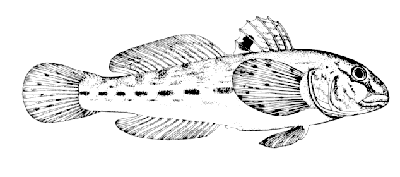 |
The round goby Neogobius melanostomus
|
